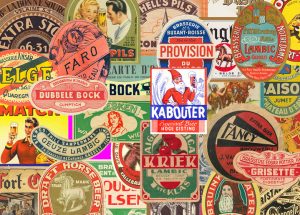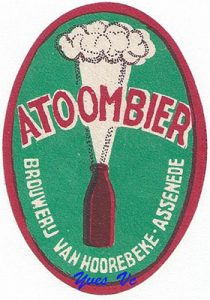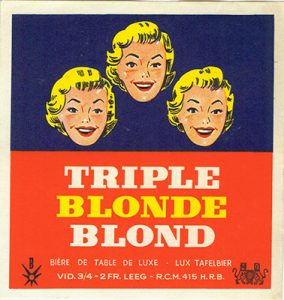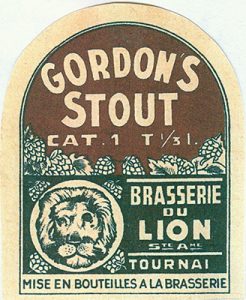Big data: Jacques Trifin’s beer labels
 A wonderful resource for historical Belgian beers is label collector Jacques Trifin’s website. Not only does he own about 28,000 beer labels, he also joined forces with other collectors in making an online database with all these nostalgic gems. On top of that, the website is very useful to make some very interesting quantitative analyses…
A wonderful resource for historical Belgian beers is label collector Jacques Trifin’s website. Not only does he own about 28,000 beer labels, he also joined forces with other collectors in making an online database with all these nostalgic gems. On top of that, the website is very useful to make some very interesting quantitative analyses…
At times, researching Belgian beer history can be a real mer à boire. So much literature to read, so many locations to visit, so many people to talk to. For my book about Holland things weren’t so exhaustive, simply because there were less sources and less literature. Therefore, in Belgium it’s nice to be able to use some ‘big data’ once in a while. It has its limitations, but also can lead to new insights.
 Hainaut-based Jacques Trifin once started out as a collector of beer glasses. But after two years, he already ran out of space in his house in the village of Chièvres, with the two thousand glasses he had laid his hands on. The switch to labels was born out of necessity: they took less space.[1]
Hainaut-based Jacques Trifin once started out as a collector of beer glasses. But after two years, he already ran out of space in his house in the village of Chièvres, with the two thousand glasses he had laid his hands on. The switch to labels was born out of necessity: they took less space.[1]
He has been collecting for twenty years now, and what’s more, he is so nice as to share his collection with the world. The website jacquestrifin.be may look a bit old-fashioned, but it is being updated regularly, because it’s still far from being a complete representation of his collection. Also, Jacques shares labels owned by fellow collectors.
All-in all it’s quite a reference work. And although the website doesn’t have a search function, you can still find your way through it quite easily, if you’re a bit tech-savvy. It’s a lot more usable than a few huge books about lost Belgian breweries that have been published over the last few years by Adelijn Calderón and by François Verhofstadt, both of them amateur enthusiasts. Sure, these books are nice initiatives, but in reality you’re paying huge sums (up to 90 euros per book!) for printed-out excel sheets, not searchable at all, and therefore of little value to me. I wouldn’t have minded if these gentlemen had simply put their data online.
 Anyway, it’s great to simply browse through Jacques Trifin’s website, through labels of breweries that still exist, and through those that have closed down. Not only are there real gems of retro design, you also stumble upon the weirdest brands and beer types. Fake trappists like ‘Trappistine’ and ‘Trap’Ale’ but also ‘Atoombier’ (Atom beer), ‘Triple-pils, contains all its vitamins’, ‘Triplor family’s beer’, ‘Dictator’ (with a picture of Mussolini) and much more. If you look closely you can see one former beer trend after another, like all 1950s beers ending in ‘or’ (Goldor, Dortor, Munchor, Belgor…).
Anyway, it’s great to simply browse through Jacques Trifin’s website, through labels of breweries that still exist, and through those that have closed down. Not only are there real gems of retro design, you also stumble upon the weirdest brands and beer types. Fake trappists like ‘Trappistine’ and ‘Trap’Ale’ but also ‘Atoombier’ (Atom beer), ‘Triple-pils, contains all its vitamins’, ‘Triplor family’s beer’, ‘Dictator’ (with a picture of Mussolini) and much more. If you look closely you can see one former beer trend after another, like all 1950s beers ending in ‘or’ (Goldor, Dortor, Munchor, Belgor…).
But I also thought it would be nice to plough through the website in a more systematic way. After all, these labels have a story to tell about what beers Belgian breweries used to make in the past. Although already in 1888 printers were advertising their labels to Belgian brewers, bottled beer, and thus labels, only became mainstream in Belgium after the First World War.[2]
On Trifin’s website I took the closed-down breweries section, containing more than 700 breweries in total. A section that is far from complete by the way: in 1920 Belgium still had about 2,000 breweries, and just before the Second World War there were still about a thousand left. Also, Jacques is still in the process of putting everything online: of the province of West Flanders, only the breweries in places starting with A and B have been added so far. The provinces of Antwerp, Liège and the Brussels capital region are still missing completely. I also omitted the section with breweries that still exist.
With that in mind, I unleashed my search engine on it with a number of search terms. Is it possible to get an idea of which beers these Belgian breweries produced, based on this website? I searched for words like ‘pils’, ‘bock’, ‘saison’, ‘spéciale’, ‘wit’, ‘dubbel’, in various linguistic varieties where needed. And that still gives an interesting sample of Belgium as a beer country in roughly the period 1900 to 1970.
 Of course, in such a list there’s some contamination to be expected: you also find beers like ‘double pilsen’ or ‘special export’, which obviously aren’t what we would think of as a double beer or spéciale (belge). Interestingly (or perhaps not), general terms like blonde, brown, double and triple (or their French and Flemish equivalents) are quite frequent. It seems that it is mainly the older labels that carry these names. Besides, the names ‘double’ and ‘triple’ may evoke today’s heavy abbey beers, but it would seem that here they refer to slightly heavier versions of simple weak table beer. The last surviving equivalent of these beers are still to be found in every Belgian supermarket: it’s the 3% ABV Triple Piedboeuf, together with its little brother Brune and its sister Blonde, both at 1% ABV, with plastic screw cap bottle.
Of course, in such a list there’s some contamination to be expected: you also find beers like ‘double pilsen’ or ‘special export’, which obviously aren’t what we would think of as a double beer or spéciale (belge). Interestingly (or perhaps not), general terms like blonde, brown, double and triple (or their French and Flemish equivalents) are quite frequent. It seems that it is mainly the older labels that carry these names. Besides, the names ‘double’ and ‘triple’ may evoke today’s heavy abbey beers, but it would seem that here they refer to slightly heavier versions of simple weak table beer. The last surviving equivalent of these beers are still to be found in every Belgian supermarket: it’s the 3% ABV Triple Piedboeuf, together with its little brother Brune and its sister Blonde, both at 1% ABV, with plastic screw cap bottle.
There are a few English beers like pale ale, Scotch and Christmas on the list (and also many beers with the suffix ‘-ale’ that I couldn’t find, because such a short search term gets you too many incorrect hits). Surprisingly high on the list is saison, a beer type made by 84 breweries on the website. I’ll give a more in-depth analysis of these at a later time. Unsurprisingly, there is also a lot of German-style bottom-fermented beer: a lot of export, bock and pils. Face it: this is what many 20th century Belgian breweries, also the little ones, used to make. And a lot of it.
 Still, the number 1 beer style in this survey is quite a surprise: stout. 219 out of the 710 closed-down breweries on Jacques Trifin’s website produced this dark English beer type. Stout must have been a very popular beer in Belgium for quite a while! I think there are two explanations for this: on one hand British beer was very much in demand in Belgium, because it was seen as quality beer. On the other hand, for small, old-fashioned breweries a top-fermented beer like this was relatively easy to produce. Rose’s Royal Stout from Bruges, London Imperial Stout from Tienen, Star Stout from Marcinelle, Gordon’s Stout from Tournai: they all tried really hard to look like English beer and to please potential Belgian customers in this way. (It certainly wasn’t exported: Belgian exports were close to zero until the 1960s.)
Still, the number 1 beer style in this survey is quite a surprise: stout. 219 out of the 710 closed-down breweries on Jacques Trifin’s website produced this dark English beer type. Stout must have been a very popular beer in Belgium for quite a while! I think there are two explanations for this: on one hand British beer was very much in demand in Belgium, because it was seen as quality beer. On the other hand, for small, old-fashioned breweries a top-fermented beer like this was relatively easy to produce. Rose’s Royal Stout from Bruges, London Imperial Stout from Tienen, Star Stout from Marcinelle, Gordon’s Stout from Tournai: they all tried really hard to look like English beer and to please potential Belgian customers in this way. (It certainly wasn’t exported: Belgian exports were close to zero until the 1960s.)
It all shows to what extent the Belgian market was dominated by foreign beer styles. Oddly, typically Belgian beer styles like gueuze, kriek and white beer are way behind. Maybe it’s because luxury beers like stout, export and pils were more likely to be bottled, while domestic beer types were more often sold in barrels. Also, a few regions are missing on the website, like Brussels. Yet, a relatively cheap Belgian beer like faro does rank relatively high. In any case, there still remains a lot of research to be done.
You’d like to taste a nice Belgian stout now? For a long time, stout in Belgium was virtually extinct. There are a few new brewers producing it again, but almost none of the traditional Belgian breweries (that is, founded before 1980) still makes it, if I’m not mistaken. Leroy in Boezinge is the exception: their website proudly features their ‘atypical variant of English stout’ at 5% ABV. Also, Dupont reintroduced its long lost Monk’s Stout in 2010. Which tastes fine as well.
Survey of beer types on labels of closed-down breweries on jacquestrifin.be
|
Stout |
219 |
Munich |
35 |
Note: the website jacquestrifin.be currently contains labels of 710 closed-down Belgian breweries. I searched through the website using the search terms seen above. For each term, the number of breweries is given for which these terms gave a result.
[1] http://www.dhnet.be/regions/tournai-ath-mouscron/il-possede-28-000-etiquettes-de-bieres-51b7609ee4b0de6db97adb0c
[2] Henk Anseeuw et al., Brugse bierhistories. 25 jaar ‘t Hamerken, VZW voor brouwerijgeschiedenis, Brugge 2013, p. 84.






Have you found any historical recipes for a Belgian-made Stout? That sounds pretty intriguing and I am curious if it is simply an English-type beer made on Belgian soil or if they modified the recipe with what they had available in Belgium.